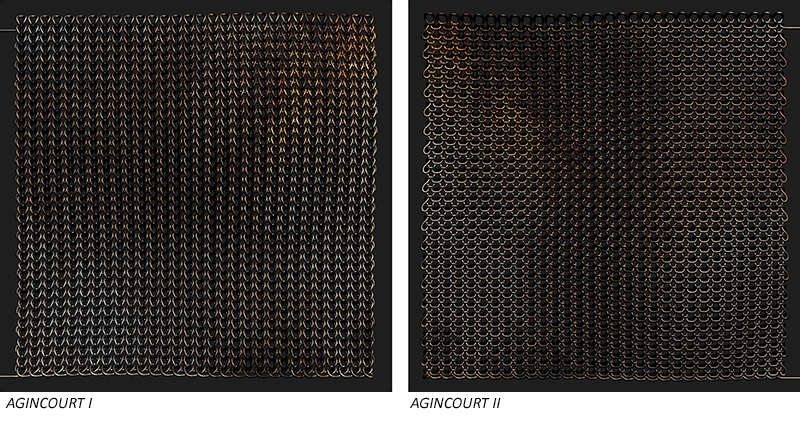On the fateful morning of the Brexit vote London Group member Angela Eames was getting to grips with her latest piece of computer knitting. Here are her thoughts :
“As late as 1905 Great Britain stood practically alone in the world. British isolation was enforced rather than voluntary, and as powerful hostile coalitions directed against this country were always possible, and sometimes actually threatening, there was nothing splendid about this isolation…”
Brexit: The withdrawal of the United Kingdom from the European Union.
From: 2012: blend of British (or Britain) and exit, probably on the pattern of Grexit (coined earlier in the same year).

It was Friday, June 24, 2016, the day of the EU referendum result. She was due to visit a gallery in Tenterden that morning and as she drove over from Northiam in bright sunshine and clear skies, a sense of speculative optimism tussled with the knowledge gleaned from the BBC news reports that the United Kingdom would be leaving the EU. Despite the latest poll of polls showing that 51% of voters want to stay in the EU and 49% want to leave, the UK had voted to leave the EU by 52% to 48%. Blimey – close or what? No amount of sunshine was going to change that.
On returning home to the studio she set about work. She had been knitting of late – within the computer. The current knit and purl pieces were the culmination of many and varying attempts to build and manipulate a single linear wireframe within a modelling environment. Usually her computer just crashed! Early balls of wool had been made using her first machine, bought in 1988 – an Amiga with a massive 8MB RAM. Naturally she had upgraded this to 16MB as soon as she could! Her next machine was custom-built by a company in Cambridge known as Red Box and was to last the next ten years, its state-of-the-arts status having then expired. This machine had enabled her to enter computing three-dimensionality in the form of Corel Draw but the next ten years saw her using 3D Studio Max within a custom-built Dell XP 630 machine. In 2014, with a new Dell, the fourth update in computing capacity, she finally managed to produce a piece of knit/purl with thirty stitches and thirty eight rows.
Her recently completed works, Armistice_red_knit and Armistice_blue_purl, referenced poppy and cornflower fields respectively. Though not particularly concerned with the poppy as symbolising remembrance (more a outright love of poppies and cornflowers) she had in researching become aware that just as the red poppy had been adopted as the commemorative emblem within the UK, the cornflower had similar significance in France. Her knitted swatch became simultaneously a knitted field of poppies and a purled field of cornflowers. The membrane, the knitted object itself could be viewed from the front or from the back (or from any other viewpoint for that matter) but front and back would suffice. Two oppositional views of the same object, lit only from one side, could provide two similar but different renders – both sides of the same coin so to speak, in this case, one red, one blue – unity and difference. The drawings underway on that fateful June morning consisted of renderable line that had been turned and twisted in virtual space to form her usual knitted swatch. She was intending to map the wireframe with imagery extrapolated from the natural world and had been looking forward to playing with the surface qualities of bright shiny metals and the interplay of projected light in her virtual world but on this morning a predictable sense of cataclysmic calamity set in. This was no time for sparkling stainless steel or iridescent aluminium – this was a time for rust and corrosion..!
She started out on the hunt for suitable rust and before long had gathered an image repository of multifarious metals in varying states of change and decay. These were to provide a visual reference for making texture maps that she could apply to the knitted objects. Agincourt I and Agincourt II employed mapping of rusting steel and as she worked at rendering the polygonal surfaces her mind was focused on ideas of fabrication and purpose, new and old and not least the conservation of past relics – she began to contemplate chain-mail. Though early chainmail was made originally by riveting rings of metal together and this was certainly a future option, she felt that her knitted swatch nevertheless alluded to this rather peculiar fabric. Metallic line enters the frame passing through regular positional repetitions of the knit zone and then finally leaves the frame. These were the final images and they seemed to reflect upon on a time well-past, protective clothing invented as a necessity in time of war. She was looking backwards rather than forwards. These were Brexit pieces all right! It seemed an opportune time to step away from the knitted membrane and to entertain the making of her own copper chain-mail as linked rings using hammered copper and its affirmative transition to a blue-green patina. Though her choice of materials had until this point been imbued with the somewhat negative attributes of decay, decline and despondency, here, in Verdigris, was a glimpse of optimism. Here shimmer and glimmer could be heightened by and contrasted with the subtlety of understated, absorbent colour. Here she could depose jingoism and positively convey change through linkage….
HOPE!
Angela Eames, 2017
From “Passing Pluto” – a collection of short stories in the third person by Angela Eames. The stories contextualise individual works of the artist/drawer, with an introduction by Dr Jess Potter. Due for publication August 2018. Details available shortly on www.angelaeames.com
Upcoming exhibition:
S C A P E – recent works by Angela Eames.
Linden Hall Studio, 32 St George’s Road, Deal, Kent CT14 6BA
From Sunday, 05 Aug 2018 – Sunday, 26 Aug 2018
